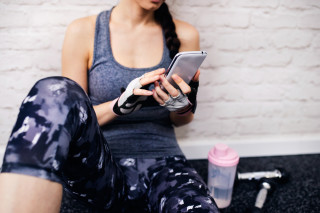By: Angie Horjus, NBC-HWC
How are you keeping yourself calm these days? COVID-19 concerns continue to grow and as I’ve been talking with my health coaching clients, I’m hearing their honesty about feeling anxious and struggling to find calm in the chaos. We’re all feeling it right now.
I remind them that they’re not alone, and we start to talk through solutions. Remember, there is time (a gap) between what happens to you (stimulus) and your choice to respond to it (response). We have more control over how we respond to a situation than we realize.
Let’s look at some ways to help you remain calm and stay focused on the positive that is still around you.
- Push pause.
For just a moment and be in this very moment. It’s helpful to recognize that right here, right now, you are OK. Take a second to notice that. Say out loud or write in a journal or on a piece of paper: “Nothing bad is happening to me in this moment.” Sometimes it’s good to take a break from anxiety and fear and put it back in its place, even if just for a moment. - Remember that you get to choose how to respond.
Over the course of time and evolution, we humans actually have a triune brain which reassures us that we can choose how we react or respond to situations that are challenging like this. The concept from American neuroscientist Paul MacLean divides the brain into three regions:
-
- Reptilian or Primal Brain (Basal Ganglia) – this is the one being used when you see people buying TONS of toilet paper. This is the fear-based and reactive part. The reactive part of our brain that signals us to, RUN called, “fight or flight.”
- Paleomammalian or Emotional Brain (Limbic System) – This is the one with all the feels. My dog has this, he’s a mammal. The emotional part we are all having to face. Our emotions are high right now. Yep, we are mammals.
- Neomammalian or Rational Brain (Neocortex) – This is the one I want to tap into more with you. This is the third layer that separates us from the animals. Humans have the capability to respond vs. react. This is where we take that quick break and know we are in a scary place, but that there are also answers. We can reasonably deduct that the answers are out there, but we just don’t know them right now. And that is OK, they will come when they are supposed to. This part of our brain allows us to know that there is a beginning, a middle and an end to everything and we will get through this time.
When it comes to choosing how you respond to frightening times. Viktor Frankl (an Austrian neurologist and psychiatrist along with being a Holocaust survivor), said it best.
“Between stimulus and response there is a space.
In that space lies our freedom and power to choose our response.
In our response lies our growth and freedom.”
~ Viktor Frankl
Frankl teaches us that in the worst of times, we can choose to focus on that space and expand it in order to survive the unthinkable. Then not only survive, but thrive.
- Change your space.
Have you been sitting at the kitchen table day and night home-schooling the kids, working, ordering supplies and eating? Are you working in your bed and then sleeping there? Just like in the non-COVID-19 world, balance is crucial to calm. Get outside if the weather allows it with these ideas or get moving in another space inside your home with these home workouts. If you’re working from home, space and schedule boundaries are critical. These tips can help.

- Pivot to the positive.
Negative thinking can seriously impact your sense of calm. Every person has approximately 50,000 to 70,000 thoughts per day. Unfortunately, 80% of the time we tend to focus on those thoughts that are negative, as opposed to concentrating on the positive. As a health coach, I’m often asked by clients if there are health benefits to positive thinking and the answer is yes. They include lower rates of depression, better cardiovascular health and even greater resistance to common colds. Not to mention better coping skills during times of stress. Here are some helpful positive thinking tips I’ve shared to help.

- Focus on what you can control.
You can’t control the number of cases or the spread of the virus. You can’t control shortages in supplies that used to be so easy to find—from toilet paper to favorite foods. What you can control to keep calm and productive, is how you use your time in quarantine, especially your free time. Make a plan to keep up your basic healthy habits during this time with these tips. You can even turn what could be a stressful task of cleaning and disinfecting into a fun, stress-busting workout with my recommended steps here. Or maybe this is a time to control the space you’re in. Now’s a great time to focus on home or yard projects like these ideas. - Think outside of yourself.
There are many Michiganders who need help right now—from frontline health care workers to those who’ve lost employment and need food or other essential resources. The mental health benefits of volunteering have long been recognized. Those who donate their time have higher self-esteem, psychological wellbeing and happiness, and growing evidence suggests that those who give back can also have better physical health.
Here are some ways to help:
-
- Donate blood – safe donations are set up statewide.
- Make cards to mail to nursing homes or hospital patients who can’t have visitors.
- Decorate your sidewalk or driveway with chalk—include happy and light messages for those out walking or jogging.
- Sew and donate masks – there are drop-off sites like this one.
- Help senior and Michigan aid organizations providing resources during this time. See statewide volunteer ideas here.
- Take a tech break.
COVID-19 is all over the news, our social media feeds and pretty much everywhere you look. While it’s important to stay informed, the Centers for Disease Control and Prevention (CDC) recommends taking frequent breaks from news stories and social media during this time. Maybe it’s for 20 minutes a few times a day and after 9 p.m. at night so you can rest peacefully. You can always check back in in the morning. Or, try setting media check-ins at set times per day. Whatever is comfortable for you is a schedule you should also stick to so you can give your brain a break.
- Get back to the basics.
What I mean by this is, your basic five senses. To calm down during periods of high stress or even a potential anxiety attack, behavioral health experts recommend trying this exercise.
Sit quietly. Look around you and notice:
-
- 5 things you can see: Your hands, the sky, a plant on your table, a picture, a tree outside.
- 4 things you can physically feel: Your feet on the ground, a coffee cup, a pillow, a button on your shirt.
- 3 things you can hear: The wind blowing, a dog barking, your breath.
- 2 things you can smell: Coffee, soap.
- 1 thing you can taste: Grab a mint or gum or take a sip of water.
This exercise helps you shift your focus to your surroundings in the present and away from what’s making you feel anxious.
There are other ways to calm your mind and put your anxiety at ease. Meditation can be a great solution for letting go of daily stress, frustration or anxiety. Mental and emotional stress can affect how you feel physically. Often when people are stressed, they feel tired, irritable and are more prone to sickness. By meditating and calming your mind, you are also calming your body. Mindful breathing is one of the easiest ways to practice meditation. A meditation app such as Headspace may be a helpful tool to get you started.
- Don’t go it alone.
Since human beings are social creatures at our core, isolation can lead to depression or increase your anxiety. Set up a video chat to connect one on one or in groups small to large using the many tech tools available like Zoom, Facebook messenger, FaceTime, Google Hangouts, Skype and others. Feeling isolated while you work from home? Turn on that video during virtual meetings, schedule video chat lunches or team happy hours. And by all means, just pick up the phone and call a friend or loved one—better yet, give your grandparents or other older relatives a call. With so much typing and texting while working or studying remotely, good old-fashioned phone calls to hear others’ voices can lift your mood instantly.
- Do what works for you.
What calmed you down before COVID-19? Is it a bubble bath, cooking, writing in a gratefulness journal or reading by the fire? And don’t forget that it’s OK to have fun. This is a scary, stressful time but you—and especially if you have kids at home—still need to have a little fun each day. Maybe it’s an impromptu dance party, healthy Taco Tuesday, movie night, family game night or yard games, or a virtual video play date. Here are even more ideas.
You have the tools you need to stay calm during this pandemic. And if it’s getting to be too much, and you’re finding you’re not able to calm down, it might be time for some professional help. See behavioral health resources here. Priority Health has also partnered with a digital health specialist to offer free access to mental wellness resources specifically focused on the COVID-19 pandemic. Learn more here.
About the Author: Angela Horjus, NBC-HWC, NASM-CPT, FLT-LE is among the first National Board Certified Health & Wellness Coaches at Priority Health, and in the U.S. Her professional career in both health coaching and physical fitness continues to fuel her love for writing to encourage self-knowledge and personal growth in her clients. Angela also has an English degree from Grand Valley State University. Her energy and positive approach to mental and physical fitness are truly motivating to both her health coaching and fitness clients.


